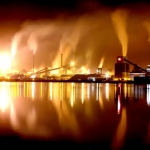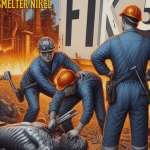URUGUAY: Mixed Reactions to Truce in Pulp Mill War
Activists who have been blocking international bridges between Argentina and Uruguay for the past month to protest the construction of two paper pulp factories on the Uruguayan side of a river separating the two countries expressed mixed reactions to news that the two governments had reached an agreement for a temporary freeze in construction on Saturday.
Presidents Néstor Kirchner of Argentina and Tabaré Vázquez of Uruguay reached a sort of truce Saturday in Chile in the ongoing conflict over pulp mills that two foreign companies - Botnia from Finland and ENCE from Spain - are building on the Uruguay River, which according to activists and officials in Argentina will cause water and air pollution.
The agreement reflects the terms proposed by Kirchner early this month, when he asked for work on the two factories to be suspended for 90 days until their environmental impact could be determined by independent experts.
In exchange, the Argentine president promised to take measures to get activists and local residents of towns along the border in the eastern Argentine province of Entre RÃos to lift the roadblocks that have been stopping traffic across bridges connecting the two countries.
While some of the protesters described the agreement as a key step towards a final solution to the conflict, others said they would continue to block traffic. In any case, the activists said they were waiting for a formal announcement by the two governments before deciding what their next step would be.
Kirchner and Vázquez were in Chile to attend the inauguration of Michelle Bachelet as president.
According to the global environmental watchdog Greenpeace, outgoing Chilean President Ricardo Lagos urged the two leaders to take advantage of their visit to Chile to seek a solution to the ongoing conflict.
A source in Montevideo, the Uruguayan capital, told IPS that the meeting in Chile was arranged this week by Vázquez's chief of staff, Gonzalo Fernández, and Argentina's cabinet chief, Alberto Fernández. "This week's contacts were preceded by a series of secret meetings between the two officials in the Buenos Aires residence of Uruguayan Ambassador Francisco Bustillo," said the source, who preferred to remain anonymous.
Kirchner and Vázquez announced their agreement after meeting for breakfast at the Sheraton Hotel in Santiago, and appealed to "the solidarity and brotherly feelings" between their countries to seek a definitive solution to the conflict.
The task now is to convince the companies, as well as the activists in Entre RÃos, to accept the truce and allow a team of high-level independent experts to assess the potential environmental impact of the factories.
The negotiations will include two more meetings between the presidents, the first of which will take place in the Uruguayan presidential residence of Anchorena, 30 km from the southwestern city of Colonia, and the second in the western Argentine resort city of Mar del Plata.
The production and bleaching of wood pulp, the raw material for producing paper, uses large quantities of water and chemicals, including chlorine and chlorine dioxide, caustic soda, oxygen peroxide and sodium hypochlorite. These chemicals generate highly toxic organochlorides (dioxins and furans), which persist in the environment and accumulate in the tissues of animals.
Botnia and ENCE say they will use the most advanced technologies in order to minimise the risks of pollution. But the Argentine government has called for independent environmental impact studies and insists that it has not received all of the necessary information from Uruguay.
Members of the Citizens Environmental Assembly in Gualeguaychú, a town in Argentina located across the border from the two pulp plants, whose residents have led the fight against the factories, had varied reactions to Saturday's announcement by the two presidents.
One member of the group, Alejandro Gahan, told the Radio Mitre station in Argentina that the agreement between the presidents was "wonderful news" and "a fundamental step" towards settling the conflict.
But other activists took a different stance. Alejandra Crimella told IPS that the protesters were still awaiting official confirmation from the governments, as well as the response by the two companies.
"Although we had stated that we would not lift the traffic blockades until work on the factories was suspended, now we say a freeze in construction is not enough to change our position on the roadblocks. That proposal isn't good enough for us anymore," said Crimella.
Foreseeing an announcement of some kind by Kirchner and Vázquez, the Gualeguaychú Citizens Environmental Assembly issued a communiqué Friday night in which it stated that it "rejected a freeze in construction as a condition for taking a more flexible stance regarding the roadblocks," and confirmed its staunch opposition to the installation of the factories, regardless of the environmental controls and safeguards that might be adopted.
Crimella said the Assembly expects to meet soon in order to define its position, as soon as it has received concrete information from the two governments and has been informed of the stance taken by Botnia and ENCE.
On Friday, the Chilean police arrested six Greenpeace activists who had unfurled a 10-metre-high banner outside the Santiago international airport, inviting the presidents of Argentina and Uruguay to visit the RÃo Cruces nature reserve in southern Chile, where the waste dumped by a wood pulp mill caused an environmental catastrophe.
The RÃo Cruces sanctuary, located 840 km south of the Chilean capital, was home to Latin America's largest population of black-necked swans (Cygnus malencoriphus), with 4,000 to 6,000 birds. But in late 2004, hundreds of swans and birds of other species began to die, because the waste discharged into the marsh by the nearby Celulosa Arauco y Constitución (Celco) pulp factory killed off a water plant that served as the birds' main source of food.
Greenpeace and other environmental organisations accuse the government of outgoing President Lagos of favouring the investment by the business group that owns the Celco plant, which is headed by Italian-born tycoon Anacleto Angelini, rather than protecting the local communities and the RÃo Cruces wetlands reserve in compliance with international treaties on the environment.
After the Celco plant was temporarily shut down and fined several times, the authorities finally allowed it to reopen in August 2005 on the condition that it build a channel so that the liquid waste that Celco dumped into the RÃo Cruces river and nearby wetlands would be diverted to the Pacific Ocean instead. That foreshadows a new conflict, with small-scale fisherfolk at MehuÃn Bay, where the channel will run into the sea.
The international repercussions of the ecological disaster in the RÃo Cruces reserve have had an impact on the controversy unleashed by the construction of the two factories on the Uruguay River.
"We believe it is, at the very least, a disgrace that President Lagos offered the Uruguayan and Argentine presidents an opportunity to debate an issue that he refused to resolve during the last two years of his term," Greenpeace Chile spokesman Samuel Leiva told IPS.
In Leiva's view, Lagos showed a "flagrant lack of environmental responsibility" in the Celco case.
"We hope President Bachelet will not only address this issue with a greater sense of urgency, but will also care enough to demand real solutions," he added.
Greenpeace, which is also taking part in the campaign against the Botnia and ENCE plants, is demanding that Chile, Argentina and Uruguay adopt a plan for clean production by the paper and pulp industry, based on the most stringent environmental standards.
* Marcela Valente in Buenos Aires and Diana Cariboni in Montevideo contributed to this report.
- 204 Manufacturing



